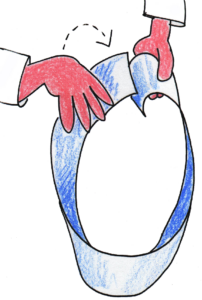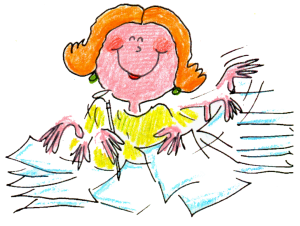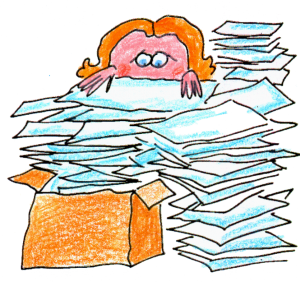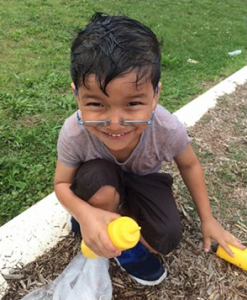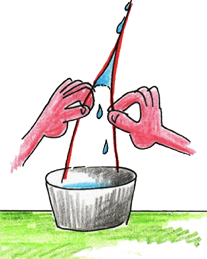Kids can try it at home with scrap paper, scissors, and tape. It’s very adaptable for different ages and abilities.
Watch the video to see what happens. Try it yourself.
Keep track of the number of twists before you tape the paper to find the pattern for how many twists results in how many loops.
It’s fascinating for both children and grownups!
Consider collecting papers in alphabetical order.
Students line up and the first person in line collects all the papers. If a student forgot to put a name on the paper, the collector can gently remind the student.
A different person is assigned as the “paper manager” for each date in a month based on each student’s last name.
This makes it much easier to record grades.
images by Education Graphics Group Do you want to publish a weekly communication? Parents say they appreciate it, kids love seeing their names mentioned, and it can keep everyone up to date on coming events. What can you do to keep it from taking two or more hours to write, print, and distribute each week? Focus on why you are writing a newsletter If you write about every subject, mention many students, give a detailed overview of the curriculum, AND a preview of coming events your newsletter will be L-O-N-G. It takes time to write and may not be read by parents. Define the purpose of your newsletter. Is it reminders, …
Students need timely feedback. While a student is wondering “I’m not sure about that last question” you have a great opportunity to capitalize on this interest to review answers. Tomorrow or the next day that student might not remember the assignment or the quiz. If you don’t need the information from the assignment to assess student understanding or plan activities here are a few suggestions for giving feedback quickly. Here’s your obvious choice: Project the answers or hand out answer keys. Students correct their own papers. This can be an opportunity to discuss an answer that students identify as needing clarification. Note: I usually avoid …
Does it seem like there’s always papers to grade? Are there stacks of paper on your desk and a few more on the shelf? What information do you need to adjust your teaching and plan future lessons? Students need timely feedback, does it take an hour or more every day? Here are a few suggestions: Grade one assignment each day and set up the other assignments for students to grade themselves Plan ahead so you have time to grade an assignment that needs more time, like an essay Learn to quietly grade papers during a staff meeting IF your attention …
I started this six weeks ago planning to publish July 1st. I was sidetracked creating back to school products for adorable aliens, fabulous fish, and superhero kids, products that help teachers easily create a great classroom space with just one product. Now those products have been uploaded and I’m back! Here’s my question. Did you make a list of tasks to complete in the summer when you have LOTS of time? I’d like to add something to that list. Between chapters in the book you’re finally reading, closets that are getting cleaned out, and your plans for rest and recreation, think about your energy …
Check out this great article Justin Minkel wrote for Education Week with practical suggestions for ending your school year. Consider signing up for a free subscription to three articles a month so you can read the article he referenced about building a parachute for a thrill-seeking gummy bear. I hope you enjoy the end of your year! Note: The photo was taken by Justin Minkel.
Thanks to what I learned while taking a great class from Michael Grinder mid-career, I have dedicated different parts of my classroom to a unique purpose. I find this gives students a nonverbal clue that helps them make sense of our environment. When anyone is standing or sitting in the front of the room, we are sharing information or instructions for an activity. We’re focused on the presenter. We might be discussing, clarifying, or sharing with each other. When I’m sitting at the small table by my desk, I’m working with a small group of students. The rest of the group is working on an activity I’ve already …
It’s 1985 and I’m a “new to science” teacher. The principal and the parents haven’t expected me to teach science, just the basics, so that’s what I’ve been doing. Then a life changing event occurs. Marie came to see me to talk about her son and offered to teach anatomy. Sure, I’m not teaching science, why not let her? Students who couldn’t pass a spelling test learn how to spell the muscles she was explaining. (Did you know the levator anguli oris, levator labii superioris, orbicularis oculi, risorius, zygomaticus major, and zygomaticus minor make it possible for you to smile?) Students who couldn’t focus in my lessons focus during hers. I …
Choose a favorite color or decorate it so it is easy to find. Keep it close, maybe in the front of a desk or file cabinet drawer. When there’s a breakthrough for a student who struggles, a great reaction from the class to an activity that took a LOT of planning, or an aha moment for a capable student who may be hard to challenge, jot a quick note to yourself, add the date, and drop it in the file. When a student or parent sends a positive note, add the date and the student’s full name (if it’s not in the …
